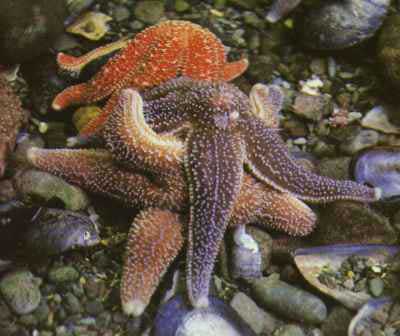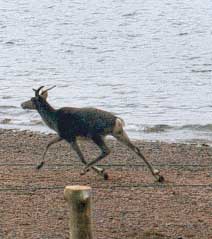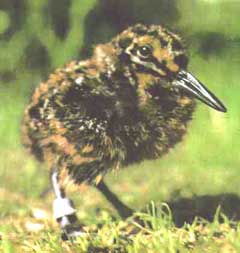Eco Adventures
EMail
CoastalSafari@
CoastalSafari.com
Telephone
1-877-888-3020 (Toll free) or
709-579-3977
Mailing Address
50 Monkstown Rd. St. John's, Nfld. Canada. A1C 3T3

The five-legged Boreal Asterias Sea Star (Asterias vulgaris), shows great variation in colour with red, purple and orange forms being common. These invertebrate marine animals inhabit intertidal regions along the Newfoundland coast. They grow rapidly and prey on mussels and other molluscs.
Along the South Coast of Newfoundland there is a five to eight foot
rise and fall of tide twice daily. The nearest tidal reporting station or
Reference Ports as they are called in the Canadian Tide and Current Tables
is at
Argentia
in Placentia Bay. The tide in Fortune Bay is 43 minutes later than at
Argentia at high water and 1 hour and 7 minutes later at low water.
Fortune Bay is very seldom frozen over but during January and February some
of the harbours freeze especially where there is an influx of
freshwater from the inflow of rivers.

Harbour Seals (Phoca vitulina) are a common sight around our
campsite. To read more about the status of seals and other marine
animals check the latest reports of the
Canadian Stock Assessment Secretariat.
To read the complete scientific papers you will need Adobe Acrobat.
![]()
Depending on the season a wide variety of birds and animals forage
in the intertidal zone for food. Caribou come down to the beaches in the
summer to eat kelp and enjoy the prevailing onshore south westerly winds
that keep temperatures pleasant.

Just back from the high tide mark a wide variety of animals find
suitable habitat for rearing their young.

Common Snipe (Capella gallingo), c. W. Montevecchi
Common Snipe (Capella gallingo) are birds of the bogs and fens of Newfoundland. The winnowing sound made by flying snipe occurs when air whistles through their tail feathers. Snipe leave Newfoundland in Fall and migrate as far as South America.
The late Dr. Les Tuck wrote a great book about snipe based on his
research in Newfoundland called The Snipes: A Study of the Genus
Capella published in 1971 by the Canadian Wildlife Service. An interesting
passage from this book describes the return of snipe to Newfoundland from
their over-wintering grounds in Louisiana, Florida and the Caribbean Islands:
“At 10:15 on April 17, 1960, the first common snipe of the year dropped
in on its former breeding range, a peat bog near St. John’s, Newfoundland.
Eight days previously, during a flow of warm
southwesterly winds, the first spring migrants had arrived at several
localities in the central portion of the island. Then followed three days
of cold, northerly winds, after which temperatures began to
rise. I had been awaiting the arrival of snipe at that study plot for
several nights and was alerted at the time by a brief spurt of bleating overhead
and a few moments of rather subdued jick-jacks as the bird alighted nearby.
The bird remained silent for about 10 minutes, but upon hearing a play-back
of similar ground calls, responded immediately and flew directly into a mist
net which I had hurriedly set up. It was a male which I had banded three
years previously at the same location and which had returned annually. The
two central feathers were somewhat frayed, suggesting that it had done considerable
bleating during the previous several weeks. It was colour-marked and released.”
![]()
